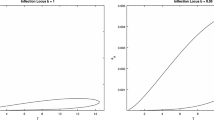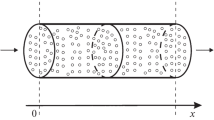Abstract
By eliminating the electrical field originating because of separation of the charged components, the Navier-Stokes equations for partially ionized multicomponent reacting gas mixtures without external electromagnetic fields are reduced to equations analogous to the equations for a chemically reacting mixture of neutral gases. Formulations of problems about flows in chemical equilibrium taking account of ionization, thermo- and barodiffusion reactions for arbitrary mixtures with different diffusion properties of the components are examined within the scope of the complete Navier-Stokes equations and the Prandtl equations of an asymptotically thin boundary layer around both impermeable and thermochemically destructible walls.
Similar content being viewed by others
Literature cited
L. I. Sedov, “On thegeneral form of the kinetics equations of chemical reactions in gases,” Dokl. Akad. Nauk SSSR,60, No. 1 (1948).
V. V. Shchennikov, “Analysis of the laminar boundary layer on a subliming surface,” Zh. Vychisl. Mat. i Mat. Fiz.,1, No. 5 (1961).
H. Hoshizaki, “Heat transfer in planetary atmospheres at super-satellite speeds,” ARS Jnl,32, No. 10 (1962).
A. Pallone and W. Van Tassell, “Stagnation point heat transfer for air in the ionization regime,” ARS Jnl,32, No. 3 (1962).
J. A. Fay and N. H. Kemp, “Theory of stagnation-point heat transfer in a partially ionized diatomic gas,” AIAA Jnl.,1, No. 12 (1963).
G. A. Tirskii, “Successive approximations to integrate the equations of a laminar multicomponent boundary layer with chemical reactions including the ionization reaction,” Report of the Moscow State Univ. Scientific-Research Institute of Mechanics, No. 1016 (1969).
O. N. Suslov and G. A. Tirskii, “Determination of the properties and calculation of the effective ambipolar diffusion coefficients in a laminar multicomponent ionized boundary layer,” Zh. Prikl. Mekhan. i Tekh. Fiz., No. 4 (1970).
J. Hirschfelder, C. Curtiss, and R. Bird, Molecular Theory of Gases and Liquids, Wiley (1964).
V. M. Zhdanov, “Transport phenomena in a partially ionized gas,” Prikl. Matem, i Mekhan.,26, No. 2 (1962).
I. Prigogine, Introduction to the Thermodynamics of Irreversible Processes, Wiley (1958).
G. A. Tirskii, “Conditions on the surfaces of strong discontinuity in multicomponent mixtures,” Prikl. Matem, i Mekhan.,25, No. 2 (1961).
V. M. Ovsyannikov and G. A. Tirskii, “Destruction of an axisymmetric body of revolution of a material of complex chemical composition in a stream of partially ionized air,” Izv. AN SSSR, Mekhan. Zhidk. i Gaza, No. 5 (1968).
R. S. Devota, “Transport properties of ionized monotonic gases,” Phys. Fluids,9, No. 6 (1966).
V. S. Avduevskii and G. A. Glebov, “Heat exchange at the forward stagnation point of an indestructible body streamlined by a stream of partially ionized air,” Inzh.-Fiz. Zh.,18, No. 2 (1970).
V. S. Avduevskii and G. A. Glebov, “Heat exchange in the neighborhood of the stagnation point on a permeable surface,” Inzh.-Fiz. Zh.,18, No. 5 (1970).
Author information
Authors and Affiliations
Additional information
Translated from Zhurnal Prikladnoi Mekhaniki i Tekhnicheskoi Fiziki, No. 1, pp. 73–89, January–February, 1971.
Rights and permissions
About this article
Cite this article
Suslov, O.N., Tirskii, G.A. & Shchennikov, V.V. Description of flows of multicom ponent ionized mixtures in chemical equilibrium within the limits of the navier-stokes and prandtl equations. J Appl Mech Tech Phys 12, 61–75 (1971). https://doi.org/10.1007/BF00853984
Received:
Issue Date:
DOI: https://doi.org/10.1007/BF00853984




